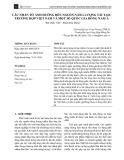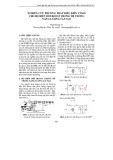
REGULAR ARTICLE
A role of electrons in zirconium oxidation
Pavel N. Alekseev and Alexander L. Shimkevich
*
NRC Kurchatov Institute, 1, Kurchatov Sq., Moscow 123182, Russia
Received: 22 April 2016 / Received in final form: 26 April 2017 / Accepted: 29 May 2017
Abstract. Growing the oxide scale on the zirconium cladding of fuel elements in pressured-water reactors
(PWR) is caused by the current of oxygen anions off the waterside to the metal through the layer of zirconia and
by the strictly equal inverse electronic current. This process periodically speeds up the corrosion of the zirconium
cladding in the aqueous coolant due to the breakaway of the dense part of oxide scale when its thickness reaches
2 mkm. It is shown that the electronic resistivity of zirconia is not limiting the zirconium oxidation at working
temperatures. For gaining this limitation, a metal of lesser valence than zirconium has to be added to this oxide
scale up to 15%. Then, oxygen vacancies arise in the complex zirconia, increase its band-gap, and thus, sharply
decrease the electronic conductivity and form the solid oxide electrolyte whose growth is inhibited in contact
with water at working temperatures of PWR.
1 Introduction
Zirconium alloys are used for fuel cladding in pressured-
water reactors (PWR), thanks to a low capture cross-
section of thermal neutrons, the good corrosion resistance
in water at high temperatures and to the mechanical
properties [1]. However, the mechanism of zirconium
oxidation is not understood so far despite the great
number of experiments carried out during the last 40 years
over studying the oxidation of zirconium alloys in the
aqueous coolant [2–7]. There is no consensus so far over
mechanisms of oxidation of metals in water [8] though this
information is very important for developing a new
cladding material of fuel elements for PWR.
2 Electrons in ZrO
2x
The stoichiometric zirconium dioxide (x= 0) without
impurities is a single stable oxide of zirconium with ionic
bond of atoms which has e
g
∼4.0 eV, and x
o
= 4.0 eV [9,10].
The oxidation of zirconium in PWR coolant according
to electrochemical reactions
Zr !Zr4þþ4e;ð1Þ
4eþ2H2O!2O2þ2H2↑;ð2Þ
Zr4þþ2O2!ZrO2;ð3Þ
is carried out by generating electrons on the interface,
Zr(O)/ZrO
2x
, over the reaction (1), by their passing
through oxide scale to the interface, ZrO
2
/H
2
O, for
disintegrating water over the reaction (2), and by diffusion
of oxygen anion back to the metal through two different
oxide layers (see Fig. 1) for oxidizing zirconium over the
reaction (3). Then, the total reaction is
Zr þ2H2O!ZrO2þ2H2↑:ð4Þ
One can see that the first layer, ZrO, is the source of
electrons for the second, ZrO
2x
, due to disintegrating
zirconia over the reaction:
0!V2þ
Oþ2eþð1=2ÞO2↑;ð5Þ
when the oxidation potential, ðkBT=4Þln PO2ðZrÞ,is
expressed by a correspondent partial oxygen pressure of
zirconia dissociation [12]
ln PO2ðZrÞ¼11:3=kBTþ19:9:ð6Þ
The oxide scale on zirconium has relatively high density
of electrons as well as the density of oxygen vacancies.
However, the electronic conductivity in ZrO
2x
film
exceeds the anionic one which allows oxidizing of zirconium
by oxygen anions diffusing over zirconia vacancies [13].
Thermodynamics of the reaction (5) can be expressed
by the following dependence [14]:
eF¼momvðxÞ=2ðkBT=4Þ⋅ln PO2;ð7Þ
* e-mail: shimkevich_al@nrcki.ru
EPJ Nuclear Sci. Technol. 3, 19 (2017)
©P.N. Alekseev and A.L. Shimkevich, published by EDP Sciences, 2017
DOI: 10.1051/epjn/2017014
Nuclear
Sciences
& Technologies
Available online at:
http://www.epj-n.org
This is an Open Access article distributed under the terms of the Creative Commons Attribution License (http://creativecommons.org/licenses/by/4.0),
which permits unrestricted use, distribution, and reproduction in any medium, provided the original work is properly cited.

where the electrochemical potential of oxygen vacancies is
expressed by the equation of ideal solution
mvðxÞ¼kBT⋅ln ½x=ð1xÞ;ð8Þ
and [15,16]
moðTÞ¼5:10 þ0:29kBT:ð9Þ
Then, it is easy to define Fermi level, e
F
, in zirconia on
the interface Zr/ZrO
2x
using the equations (6)–(9). This
level is shown in Figure 2.
One can see that in zirconia contacting zirconium,
Fermi level is shifted off the middle of band-gap to the
conduction band where quasi-free electrons (full blue line in
Fig. 2) appear [17]. Their molar concentration [e
] is given
by Fermi-Dirac statistics, which can be simplified to
Maxwell-Boltzmann one [18]:
½e¼NA⋅exp½ðeFecÞ=kBT:ð10Þ
It follows that
x¼xoþð1=2Þ⋅exp½ðeFecÞ=kBT;ð11Þ
and
½V2þ
O¼NA⋅xoþ½e=2:ð12Þ
Substituting (6),(8),(9), and (11) in (7),wefind the
first boundary condition
eFz ¼2:19 2:87kBT;ð13Þ
in the oxide scale contacting zirconium cladding and the
second
eFw ¼3:72 þ0:92kBT;ð14Þ
in the oxide scale contacting water whose oxidation
potential can be expressed by the equivalent oxygen
pressure [11]
ln PO2ðwÞ¼5:53=kBTþ20:7:ð15Þ
Equations (14) and (15) define the variation of the
concentrations (10) and (12) in the dense part of oxide scale
from 10
21
to 10
10
mol
1
for electrons and from 5 10
20
to
610
18
mol
1
for oxygen vacancies at 650 K.
3 The location of black zircon
One can see in equation (11) and Figure 2 that Fermi level
in ZrO
2x
is equal to 2.31 eV in contact with zirconium at
650 K. Thus, x= 2.31 eV for the dense part of oxide scale
(DPOS) is less than x
z
= 4.0 eV for the metal [19].
Therefore, electrons pass in zirconium from ZrO
2x
,
recharging the metal negatively and enriching DPOS
interface region by oxygen vacancies, ½V2þ
O, due to the
positive D
dl
:
Ddl ¼ðxzxÞ=e¼1:69 V:ð16Þ
The [V2þ
O] distribution in a diffusive part of the double
electric layer (dl) is described by equation [20]
mvð’Þ2e’¼mvð0Þ:ð17Þ
Substituting (8) in (17), we obtain x
dl
at the oxide side
of Zr/ZrO
2x
interface:
xdl ¼½1þx1
oexpðDdl=kBTÞ1∼1;ð18Þ
i.e. the “black zircon”, ZrO shown in Figure 1 [1]. The
thickness of this layer is defined by Debye length
L
D
=(k
B
T/4pe
2
n
v
)
1/2
which is less than 10 nm [13].
The investigation of DPOS on zirconium cladding by
analytic tools [2,3] has disclosed ZrO phase between metal
and ZrO
2x
layer at the initial oxidation of zirconium alloys
by the aqueous coolant. They have shown that the
properties of “black zircon”are more similar to zirconium
than to zirconia [4]. It means that the last grows at the
ZrO/ZrO
2
interface.
4 Growing DPOS
The oxidation rate of zirconium in water over the reaction
(2) is characterized by the following dependence on
temperature [21]
R¼151 expð1:47=kBTÞ:ð19Þ
Obviously, the interface of DPOS and water is the
vacancies and electrons sink that arise on the other side of
DPOS on contacting zirconium. Then, the sum of their
specific currents [13,22]
je¼uene
deF
dy ;ð20Þ
Fig. 1. The composition profile of dense part of the oxide scale
(2 mkm [11]) on the surface of Zircaloy-4 (SRA) taken across the
metal/oxide interface after 90-day testing in liquid water heated
up to 360 °C[1]; the dotted vertical lines separate “black zircon”,
ZrO, from zirconium and dense hypo-stoichiometric zirconia,
ZrO
2x
.
2 P.N. Alekseev and A.L. Shimkevich: EPJ Nuclear Sci. Technol. 3, 19 (2017)

jv¼uvnv
dmv
dy 2dec
dy
;ð21Þ
is equal to zero in the range of 0 yhwhen u
e
≫u
v
under
conditions
dje
dy ¼djv
dy ¼0;ð22Þ
d2ec
dy2¼a½ð2nvneÞ=KNA2xo;ð23Þ
ecjy¼0¼ecð0Þ;ð24Þ
eFjy¼0¼eFz;ð25Þ
eFjy¼h¼eFw;ð26Þ
xjy¼h¼xo:ð27Þ
Substituting (20),(21), and (23) in (22), we obtain the
steady-state boundary task for three functions: x(y), e
c
(y),
and h(y)=n
e
/KN
A
under boundary conditions (24)–(27).
For the strong inequality: gx
o
≫1 where g≡ah
2
/k
B
T,
we simplify the task (22)–(27) and find its solution in the
form of power series:
hðjÞ¼X
∞
k¼0
akjk;ð28Þ
ecðjÞ¼kBTX
∞
k¼0
ckjk;ð29Þ
xðjÞ¼X
∞
k¼0
bkjk;ð30Þ
with j=y/h. This solution implementing the equality of
the specific currents (20) and (21) at any yin the ZrO
2x
layer gives the expression for Rin the final form
R¼MoKkBTu
eða1þa0c1Þ=8he:ð31Þ
Substituting (28)–(30) in (22) and (23) under boundary
condition (24)–(27), we obtain
a1¼a0ð1þc1Þ=2;ð32Þ
c1¼a0ð2y1Þ=½4xoþa0ðyþ1Þ;ð33Þ
where a
0
= 0.057 exp(0.19/k
B
T) and y=u
e
/u
v
.
In presenting u
e
and u
v
by equation [23]
ui¼3eDi=2kBT;ð34Þ
we are transforming (31) to
R∼9MoKDva0=32h;ð35Þ
where D
v
is presented by [24] as the temperature
dependence
Dv¼1:50 106expð1:28=kBTÞ;ð36Þ
does (35) equal to (19) for h= 1 mkm.
Thus, growing the oxide scale on the zirconium
cladding of fuel elements is being defined by the product
of electronic density on the ZrO/ZrO
2
interface and the
mobility of oxygen vacancies in the dense ZrO
2x
layer.
Decreasing any of them we will inhibit the oxide corrosion
of zirconium cladding.
5 Discussion of results
After reaching the critical thickness of 2 mkm, DPOS
breaks off from the zirconium cladding surface and the rate
of metal corrosion dramatically increases as shown in
Figure 3 [5].
This process is known as the “breakaway”oxidation [5]
due to opening the unprotected zirconium surface for
oxidizers that increases the oxidative corrosion as shown in
Figure 3. At the same time, the mechanism of such the
breakaway so far is under debate in the scientific literature
and the effect of additives on this process is not understood.
Since the oxidation rate (35) depends on the maximal
electronic density in DPOS (at e
Fz
) and the mobility of
oxygen vacancies there, it is necessary to inhibit the
electronic conductivity in the oxide scale and to decrease
the mobility of oxygen vacancies. It can be practiced by
adding a metal of lesser valence than zirconium [8]. Such
the addition stabilizes a high-temperature cubic phase of
zirconia as the solid electrolyte with electronic conductivity
practically equal to zero [13,25].
Fig. 2. The electronic band structure of ZrO
2x
with free
electrons in the conduction band (full blue line) and Fermi level,
e
Fz
, (red line) expressed by equation (13) for 650 K.
P.N. Alekseev and A.L. Shimkevich: EPJ Nuclear Sci. Technol. 3, 19 (2017) 3

For yttrium-stabilized zirconia (YSZ) at its addition of
9 mol%, there is no positive effect because the band gap is
the same (∼4.0 eV) and the molar density of electrons in the
oxide scale is in the same range of 10
21
to 10
10
mol
1
(see
above) at 650 K but the molar density of oxygen vacancies
is very high ∼10
22
mol
1
[26].
In contrast, e
g
of calcium-stabilized zirconia (CSZ) is
equal to ∼5.6 eV [25]at15 mol% of the additive that
inhibits the electronic conductivity in the oxide scale for
the same m
o
(T)(9) and the dimensionless content x
s
∼0.1
of oxygen vacancies because e
Fz
(13) becomes appreciably
lower than e
c
=1.2 eV (see Fig. 4 in comparison with
Fig. 2):
eFz ¼2:28 þ1:08kBT:ð37Þ
One can find from (10) and (37) that at 650 K, the
maximal density of electrons in CSZ is less than 10
16
mol
1
.
Then, one can find a
0
= 2.94 exp(1.08/k
B
T) by using
equations (10) and (32)–(37). For the ratio a
0
(y+1)≫4x
o
,
we will obtain R(T) at zirconium oxidation via CSZ layer of
1 mkm in the form
R¼7:03 104expð2:36=kBTÞ:ð38Þ
By comparing this equation with (19), one can conclude
that the oxidation rate of zirconium cladding with the
surface thin layer of the alloy, Zr–Ca(15%), on a few orders
of magnitude less than the usual zirconium oxidation.
Then, the oxide scale on such the cladding of fuel elements
in PWR will grow up to 2 mkm during 10
5
h instead of 10
3
h
for the up-to-date cladding.
Obviously, this should be checked by a corrosion test of
such cladding.
6 Conclusions
The electronic model of the oxide scale on zirconium
cladding of the fuel elements in PWR is developed for
studying the role of electrons in the zirconium oxidation by
the aqueous coolant.
The concentrations correlation of electrons and oxygen
vacancies in forming the hypo-stoichiometric zirconia on
the zirconium cladding transforms zirconia into a mixed
conductor. However, the higher mobility of electrons in this
conductor does their concentration by the dominant factor
in zirconium oxidation.
The two-layer oxide scale is the result of the action of
double electric layer in the Zr/ZrO
2x
interface which
enriches ZrO
2x
by oxygen vacancies up to forming the
black zircon, ZrO, and facilitates the penetration of
zirconium atoms into this layer.
It is possible that the oxidation rate may be inhibited by
decreasing the electronic conductivity in the oxide scale.
For this, calcium should be implanted into the near-surface
layer of zirconium cladding for forming the calcium-
stabilized zirconia on its surface.
Nomenclature
e
electron charge (e)
[e
] the molar concentration of electrons in ZrO
2x
(mol
1
)
hthe thickness of ZrO
2x
in the dense part of oxide
scale (m)
j
i
the specific current of i-particles (e/m
2
s)
Kthe dimensional unit (4.61 10
4
mol/m
3
)
k
B
Boltzmann constant (8.62 10
5
eV/K)
L
D
Debye length of oxygen vacancies (nm)
M
o
the zirconia molar mass (0.123 kg/mol)
N
A
Avogadro number (6.02 10
23
mol
1
)
n
e
the volume concentration of electrons in ZrO
2x
equal to K[e
](m
3
)
n
v
the volume concentration of oxygen vacancies in
ZrO
2x
equal K½V2þ
O(m
3
)
PO2the equivalent oxygen pressure (MPa)
PO2ðZrÞthe same for zirconia dissociation
Rthe oxidation rate of zirconium in water (kg/m
2
s)
TKelvin temperature (K)
u
i
the mobility of i-particle (m
2
/s V)
Fig. 3. The zirconium oxidation; the blue line shows the weight
gain that would be expected for a material with a protective
barrier layer which breaks down and cyclic oxidation is
characterized by the overall linear growth [5].
Fig. 4. The electronic band structure of CSZ with Fermi level,
e
Fz
, (red line) expressed by equation (37) for 650 K.
4 P.N. Alekseev and A.L. Shimkevich: EPJ Nuclear Sci. Technol. 3, 19 (2017)

V2þ
Othe charged oxygen vacancy in hypo-stoichiomet-
ric zirconia, ZrO
2x
(e)
½V2þ
Othe molar concentration of oxygen vacancies in
ZrO
2x
(mol
1
)
xthe dimensionless degree of ZrO
2x
non-stoichi-
ometry: (x<0) for hyper-stoichiometric state and
(x>0) for the hypo-stoichiometric one
x
o
a background non-stoichiometry (∼10
5
)
x
s
the dimensionless content of oxygen vacancies off
the metal additive
ythe coordinate in the layer of ZrO
2x
(m)
athe dielectric parameter of zirconia (1.74 eV/nm
2
)
e
c
the bottom of conduction band (eV)
e
F
Fermi level in the band gap of non-stoichiometric
dioxide (eV)
e
g
the band gap of dioxide (eV)
e
v
the top of valence band (eV)
D
dl
the potential of double electric layer (V)
m
o
(T) the electrochemical potential of stoichiometric
zirconia (eV)
m
v
(x) the electrochemical potential of oxygen vacancies
in hypo-stoichiometric ZrO
2x
as a function of x
(eV)
’the electric potential in double layer (V)
x
o
the work function of stoichiometric dioxide (eV)
xthe work function of non-stoichiometric dioxide
(eV)
The authors would like to thank their colleagues for active
discussion on the aspects of electronic model in growing the oxide
scale on zirconium cladding of fuel elements for PWR.
References
1. D. Hudson et al., in Proceedings of the 14th International
Conference on Environmental Degradation of Materials in
Nuclear Power Systems, Virginia Beach (2009), p. 1407
2. B. Jungblut, G. Sicking, T. Papachristos, Surf. Interface
Anal. 13, 135 (1988)
3. C. Morant et al., Surf. Sci. 218, 331 (1989)
4. H. Gohr et al., in Proceedings of the 11th International
Symposium of American Society for Testing and Materials
(ASTM STP 1295) (1996), p. 181
5. C. Lemaignan, in ASM Handbook on Corrosion: Environ-
ments and Industries, edited by S.D. Cramer, B.S. Covino
(ASM International, Ohio, 2006), Vol. 13C
6. V.N. Shishov et al., J. ASTM Int. 5, 01 (2008)
7. J.P. Foster, H.K. Yueh, R.J. Comstock, J. ASTM Int. 5,
01 (2008)
8. P.N. Alekseev, A.L. Shimkevich, in Proceedings of the
Conference on Reactor Fuel Performance (TopFuel 2015),
Zurich (2015), Poster, p. 387
9. B. Cox, J. Nucl. Mater. 336, 331 (2005)
10. M. Inagaki, M. Kanno, H. Maki, in Proceedings of the 9th
International Symposium of American Society for Testing
Materials (ASTM STP 1132) (1990), p. 437
11. N. Ni et al., Scr. Mater. 62, 564 (2010)
12. I. Barin, Thermochemical data of pure substances (V.C.H.,
Weinheim, 1989)
13. H. Frank, J. Nucl. Mater. 306, 85 (2002)
14. V.V. Osiko, A.L. Shimkevich, B.A. Shmatko, Lect. Acad. Sci.
USSR 267, 351 (1982)
15. M.M. Nasrallah, D.L. Douglass, Oxid. Met. 9, 357 (1975)
16. R.W. Vest, N.M. Tallan, J. Appl. Phys. 36, 543 (1965)
17. N. Ni et al., Ultramicroscopy 111, 123 (2011)
18. Ch. Kittel, Introduction to solid state physics, 8th edn.
(Wiley, New York, 2004), p. 20
19. Information on http://environmentalchemistry.com/yogi/
periodic/Zr.html
20. V.A. Blokhin, Yu.A. Musikhin, A.L. Shimkevich, Institute
for Physics and Power Engineering Preprint No. 1832 (1987)
21. R.A. Causey, D.F. Cowgill, B.H. Nilson, Report
SAND2005-6006, Sandia National Laboratories, 2005
22. C. Wagner, Z. Phys. Chem. B21, 25 (1933)
23. S. Lindsay, Introduction to nanoscience (OUP, Oxford,
2009)
24. A.G. Belous et al., Inorg. Mater. 50, 1235 (2014)
25. V.N. Chebotin, M.V. Perphiljev, Electrochemistry of solid
electrolytes (Chemistry, Moscow, RF, 1978)
26. T. Shimonosono et al., Solid State Ionics 225, 61 (2012)
Cite this article as: Pavel N. Alekseev, Alexander L. Shimkevich, A role of electrons in zirconium oxidation, EPJ Nuclear Sci.
Technol. 3, 19 (2017)
P.N. Alekseev and A.L. Shimkevich: EPJ Nuclear Sci. Technol. 3, 19 (2017) 5




















![Ngân hàng trắc nghiệm Kỹ thuật lạnh ứng dụng: Đề cương [chuẩn nhất]](https://cdn.tailieu.vn/images/document/thumbnail/2025/20251007/kimphuong1001/135x160/25391759827353.jpg)





